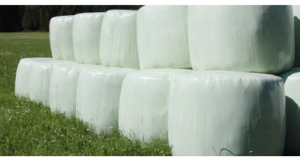The mounting use of plastic bale wrap in agriculture has sparked significant environmental concerns due to its non-biodegradable nature. This article explores the environmental implications of this widely used material and delves into viable, eco-friendly alternatives that promise sustainable farming practices.
Plastic bale wrap has been a staple in agricultural storage and transport for decades. This incredible material has revolutionised how we store and transport hay, reducing spoilage and increasing the efficiency of feed storage. However, with the escalating environmental crisis, we must reconsider using this material due to its non-biodegradable nature.
The Environmental Impact of Plastic Bale Wrap
Despite the undeniable convenience plastic bale wrap offers, it’s also contributing to the global plastic pollution problem. Plastic bale wrap, which is typically non-recyclable, often ends up in landfills or as litter in fields and waterways, posing a threat to wildlife and ecosystems. Moreover, plastic wrap production contributes to greenhouse gas emissions, exacerbating climate change.
Exploring Sustainable Alternatives
 The environmental implications of plastic bale wrap have ignited the exploration of sustainable alternatives. One alternative is biodegradable bale wrap made from plant-based materials, such as cornstarch. These materials are designed to decompose naturally over time, reducing their environmental footprint.
The environmental implications of plastic bale wrap have ignited the exploration of sustainable alternatives. One alternative is biodegradable bale wrap made from plant-based materials, such as cornstarch. These materials are designed to decompose naturally over time, reducing their environmental footprint.
The Challenges of Transitioning
While biodegradable wraps seem promising, transitioning from traditional plastic wrap poses several challenges. The cost of biodegradable materials is higher than plastic, posing a barrier for many farmers. In addition, the durability and effectiveness of these alternatives are still under scrutiny.
The Way Forward
Despite these challenges, the need for a sustainable alternative to plastic bale wrapcannot be overstated. Innovation and research are required to develop affordable, efficient, and eco-friendly options. As consumers become more environmentally conscious, the demand for such innovations will inevitably rise, propelling us towards a more sustainable agricultural industry.
Government and Industry Collaboration: Key to Sustainability
Collaboration between government bodies and the agriculture industry can catalyse the transition towards sustainable bale wraps. Governments can play an instrumental role in facilitating this shift by providing subsidies or tax breaks to farmers who opt for eco-friendly alternatives. It can help offset the higher costs associated with biodegradable materials, making them more accessible to farmers.
Simultaneously, the agriculture industry can invest in research and development to improve the efficiency and durability of sustainable bale wraps. Partnerships with academic institutions and environmental organisations can spur innovation and ensure that new products align with ecological standards and best practices.
Moreover, educating farmers and consumers about the environmental implications of plastic bale wraps and the benefits of sustainable alternatives is crucial. It can be accomplished through workshops, awareness campaigns, and community outreach programs.
Ultimately, the transition towards a sustainable agricultural industry is a shared responsibility. Government support, industry innovation, and consumer awareness are critical components in this journey towards sustainability.
Conclusion
While plastic bale wrap has long served as a convenient solution for hay storage and transportation, its environmental impact is significant. As such, developing and adopting sustainable alternatives are imperative for the future of agriculture and our planet.
